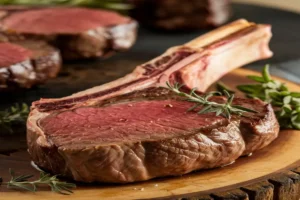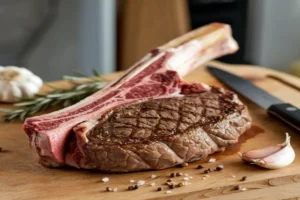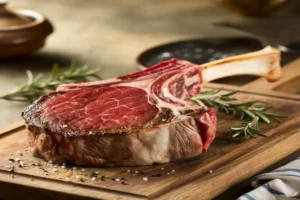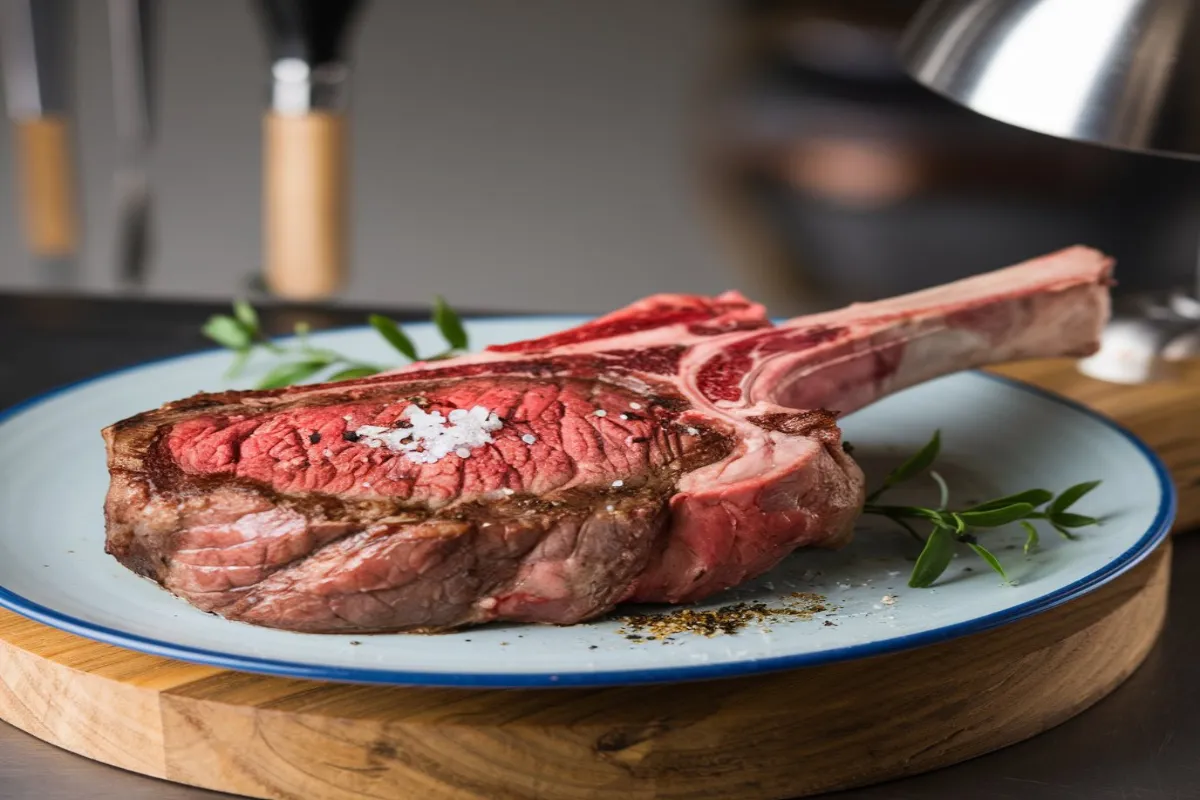Introduction
The tomahawk steak so expensive stands out as a symbol of luxury dining. This large cut of beef, with its long bone, grabs attention and often serves as the centerpiece of gourmet meals. But why does this steak cost so much? Factors like the unique butchering process, the quality of the beef, and its cultural significance contribute to the high price.
The Cut: What Makes a Tomahawk Steak Unique?
A tomahawk steak is a ribeye steak with the bone left intact, creating its signature look. However, this isn’t just any ribeye. The tomahawk cut includes a long, carefully trimmed bone, which adds to its visual appeal and increases the price.
- The Ribeye Connection: The ribeye is one of the most valued cuts of beef, known for its rich marbling and intense flavor. The tomahawk steak takes this experience further with its dramatic presentation.
- Butchering Skill: Preparing a tomahawk steak requires a skilled butcher. The bone needs to be trimmed and cleaned to achieve the right look, a process known as “Frenching.” This careful work adds labor costs and raises the steak’s price.
- Portion Size: Tomahawk steaks are cut thick, often weighing between 30 to 45 ounces. The sheer size of the steak means more meat, which naturally drives up the price.
The Quality of the Beef: Choosing Prime Cuts
The quality of the beef used plays a big role in the price of a tomahawk steak. Only the best cuts, often labeled as “Prime” in the U.S., are used for tomahawk steaks.
- USDA Prime Beef: This classification represents the top 2-3% of beef in the United States. It is known for its abundant marbling, leading to superior tenderness, juiciness, and flavor. Producing Prime beef costs more, and this cost is reflected in the price of the tomahawk steak.
- Wagyu and Kobe Beef: Some tomahawk steaks come from Wagyu or Kobe beef for the ultimate in luxury. These Japanese breeds are famous for their exceptional marbling and flavor, with prices that can reach hundreds of dollars per steak.
- Dry-Aging Process: Many tomahawk steaks go through a dry-aging process, where the beef is stored in a controlled environment for several weeks. This process enhances the flavor and tenderness but also reduces the steak’s weight due to moisture loss, further increasing the cost.
The Visual Appeal: A Showstopper on the Plate
Presentation plays a crucial role in the tomahawk steak’s appeal. The long bone, resembling a tomahawk axe, makes it a striking dish perfect for special occasions.
- Instagram-Worthy Presentation: In today’s social media-driven world, the visual appeal of food is essential. The tomahawk steak, with its dramatic appearance, often appears on Instagram and other platforms, boosting its desirability and, therefore, its price.
- Table-Side Service: Many upscale restaurants offer table-side service for tomahawk steaks. Here, the steak is presented and carved in front of the guests. This theatrical experience adds to the cost, as it requires additional staff training and time.
Supply and Demand: Market Forces at Play

Supply and demand heavily influence the pricing of tomahawk steaks. As a luxury item, the demand for tomahawk steaks often exceeds the supply, driving up the price.
- Limited Availability: Only a few tomahawk steaks can be obtained from each animal, limiting the supply. This rarity, combined with high demand from steak enthusiasts and upscale restaurants, contributes to the higher cost.
- Consumer Willingness to Pay: The tomahawk steak has become synonymous with luxury dining, and consumers are willing to pay a premium for the experience. This willingness, especially in fine dining settings, allows restaurants to set higher prices.
The Culinary Experience: More Than Just a Meal
Eating a tomahawk steak goes beyond just consuming a piece of meat; it’s about the entire dining experience.
- Flavor Profile: The marbling in the tomahawk steak ensures a rich, buttery flavor that expert grilling techniques often enhance. The long bone also adds subtle flavors as the steak cooks, deepening the taste.
- Cooking Techniques: Preparing a tomahawk steak requires skill and precision. Whether grilled, seared, or broiled, the steak must be cooked evenly, which can be challenging due to its size. Many chefs take pride in cooking the perfect tomahawk, and this expertise factors into the price.
- Dining Atmosphere: The experience of eating a tomahawk steak is often elevated by the ambiance of the restaurant. Fine dining establishments invest heavily in creating an atmosphere that complements the luxury of the meal, justifying the high price.
Economic Factors: The Cost of Production
Several economic factors contribute to the high cost of tomahawk steaks, from raising the cattle to the logistics of getting the steak to your plate.
- Cattle Raising Practices: High-quality beef comes from cattle raised with care. This often involves grass-feeding or grain-finishing, both of which can increase production costs. Additionally, ethical and sustainable farming practices, which are becoming more popular, tend to be more expensive.
- Transportation and Logistics: Getting a tomahawk steak from the farm to your table involves multiple steps, including processing, packaging, and transportation. Each step adds to the overall cost.
- Restaurant Markups: Restaurants typically mark up the cost of their dishes significantly to cover overheads such as rent, utilities, staff wages, and other operational costs. For luxury items like the tomahawk steak, these markups can be even higher.
The Cultural and Social Significance of the Tomahawk Steak
The tomahawk steak also holds cultural and social significance, contributing to its high price.
- Status Symbol: In many circles, ordering a tomahawk steak is a status symbol, showcasing one’s wealth and taste. This social aspect drives demand, particularly in high-end restaurants and social gatherings.
- Culinary Heritage: The tomahawk steak is not just a modern invention; it has roots in culinary traditions where large cuts of meat were shared among groups, symbolizing abundance and celebration. This heritage adds to the steak’s allure and, by extension, its price.
- Influence of Celebrity Chefs: Celebrity chefs and food influencers have increased the popularity of tomahawk steaks by showcasing them in cooking shows and on social media. This exposure has turned the tomahawk steak into a trendy, must-try item, driving up demand and prices.
Alternatives to the Tomahawk Steak: Exploring Other Cuts

For those who love the flavor of a tomahawk steak but find the price too steep, there are alternatives.
- Ribeye Steak: Since the tomahawk steak is essentially a ribeye with the bone attached, choosing a regular ribeye can provide a similar flavor profile at a lower cost.
- Bone-In Ribeye: For a middle ground between the ribeye and the tomahawk, consider a bone-in ribeye. This cut includes the bone, offering some of the visual appeal and added flavor of the tomahawk without the hefty price tag.
- Porterhouse Steak: Another impressive cut, the porterhouse steak includes both the tenderloin and the strip steak, offering a different but equally luxurious dining experience.
Cooking a Tomahawk Steak at Home: Is It Worth It?
Many enthusiasts wonder if cooking a tomahawk steak at home is worth it. The answer depends on various factors, including your culinary skills and access to high-quality beef.
- Sourcing the Steak: Finding a high-quality tomahawk steak can be a challenge. Some specialty butcher shops carry them, but they are not always readily available. Ordering online is an option, but shipping costs can add to the price.
- Preparation and Cooking: Cooking a tomahawk steak at home requires some expertise, particularly in managing the steak’s size and ensuring even cooking. However, the reward is a restaurant-quality meal in the comfort of your own home.
- Cost Comparison: While cooking at home can save money compared to dining out, the cost of a tomahawk steak is still significant. When you consider the time and effort required, it’s important to weigh whether the experience is worth the price.
FAQs
Why is the tomahawk steak bone so long?
The butcher leaves the long bone of the tomahawk steak intact primarily for visual appeal. This bone, which resembles a tomahawk axe handle, makes the steak a showstopper on the plate. Additionally, leaving the bone in the steak can enhance the flavor during cooking, as the bone marrow and connective tissues break down and infuse the meat.
Is a tomahawk steak just a gimmick?
The tomahawk steak’s appearance is part of its appeal, but it’s not just a gimmick. The steak is prized for its rich flavor, which comes from the ribeye cut and its marbling. The long bone adds to the experience, both in terms of presentation and flavor. However, it’s essential to recognize that the high price also reflects the steak’s status as a luxury item.
Can I cook a tomahawk steak on a regular grill?
Yes, you can cook a tomahawk steak on a regular grill, but it requires some adjustments due to its size. Indirect grilling, where you sear the steak over high heat and then cook it slowly on a cooler part of the grill, is often recommended. The large bone can make the steak difficult to fit on smaller grills, so you may need to be creative with positioning.
What is the best way to season a tomahawk steak?
Simple seasoning is usually best, given the quality of the beef. A generous amount of kosher salt and freshly ground black pepper is often all you need. Some chefs recommend adding garlic, rosemary, and butter during the cooking process to enhance the steak’s flavor further.
Is a tomahawk steak worth the price?
Whether a tomahawk steak is worth the price depends on your perspective. For many, the experience of eating such a luxurious and visually impressive steak is worth the expense, particularly for special occasions. However, if you’re primarily focused on flavor, other cuts like ribeye or porterhouse may offer a similar experience at a lower cost.

Conclusion
The tomahawk steak is more than just a cut of meat; it’s an experience, a status symbol, and a testament to culinary craftsmanship. Its high price reflects not only the quality of the beef but also the labor-intensive butchering process, the presentation, and the dining experience it provides. Whether you’re dining out or cooking at home, enjoying a tomahawk steak is a luxury that many consider worth the splurge.

